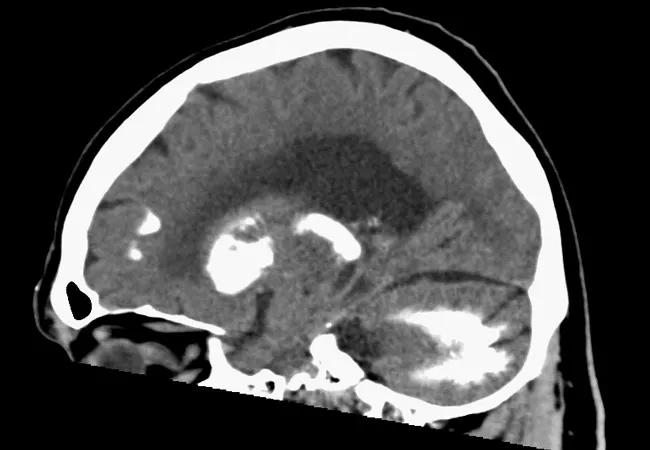Fahr’s syndrome in older man with hypoparathyroidism

Striopallidodentate calcinosis (SPD), also known as Fahr’s syndrome, is a rare condition characterized by abnormal deposition of calcium in the brain. In a poster session during the American Geriatrics Society’s annual meeting in May 2018, Anas Souqiyyeh, MD, a fellow in Cleveland Clinic’s Department of Geriatrics, and his colleagues presented a case of a 68-year-old man with idiopathic hypoparathyroidism and hypertension who complained of short-term memory decline.
Advertisement
Cleveland Clinic is a non-profit academic medical center. Advertising on our site helps support our mission. We do not endorse non-Cleveland Clinic products or services. Policy
The patient reported vision deterioration and low energy, but his physical examination was normal and he denied a history of strokes or seizures. Imaging revealed extensive symmetrical calcifications in the bilateral caudate, basal ganglia, thalamus and dentate nuclei of the cerebellum. Bilateral frontal subcortical deposits were noted as well. The patient underwent neuropsychological testing, the results of which were consistent with deficits in the frontal-subcortical domains.
“When you have a patient with any type of memory decline, it is important to consider the many subtypes of dementias affecting the cortical regions, where most of the dementias implicate, but we also have to consider subcortical regions,” says Dr. Souqiyyeh. “Any subcortical damage could lead to cortical damage, especially when there is a chronic medical condition like hypoparathyroidism that disrupts calcium homeostasis and could eventually lead to calcium deposits in watershed subcortical brain.”
Taken together, the test results, physical examination and medical history for this patient were consistent with Fahr’s syndrome, he says.
The deposits seen in patients with Fahr’s syndrome can be comprised of many elements but are usually calcium phosphate or carbonate, and are typically found in the basal ganglia, cerebral cortex, hippocampus, thalamus, dentate nucleus and subcortical white matter. Clinically, the syndrome is characterized by extrapyramidal symptoms and neuropsychiatric disorders such as Parkinsonism or chorea.
Advertisement
The syndrome is so rare that there is no data on its true prevalence and even less is known of its morbidity and mortality. “We mostly see isolated cases,” he says. Of interest, primary SPD, or Fahr’s disease, is usually genetically determined, with five implicated chromosomal regions (IBGC1-5) currently that lead to faulty calcium and phosphate channels in the central nervous system. Secondary causes of SPD related to the development of Fahr’s syndrome include hypoparathyroidism, as seen in this case, hyperparathyroidism and pseudohypoparathyroidism, brain infections and tumors, systemic lupus erythematosus, head injuries and various metabolic disturbances.
Cognitive impairment occurs in 39 percent of cases. “Cognitive deterioration is the result of neuronal disruption between the basal ganglia and the cortex,” he explains, “which eventually leads to fronto-temporal neuronal loss and the formation of cortical neurofibrillary aggregates.”
“Unfortunately, given the rarity of this condition, there is no dedicated treatment for Fahr’s syndrome, so we rely on off-label use of anticholinesterase inhibitors and NMDA antagonists,” he says. Parathyroid hormone replacement therapy is not the current standard of care in hypoparathyroidism, and it is not known if it would offer prevention or alleviate progression.
Even though this is a neurodegenerative disease, Dr. Souqiyyeh says it is important to perform neuropsychiatric evaluations periodically. “These patients often present with psychiatric changes in mood, such as depression and anxiety, which might be missed and can be treated.”
Advertisement
The current patient has been placed on an anticholinesterase inhibitor, and is also trying herbal remedies on his own. The team is working with his endocrinologist to ensure his hypoparathyroidism is controlled.
Advertisement
Advertisement

Multidisciplinary approach helps address clinical and psychosocial challenges in geriatric care

Effective screening, advanced treatments can help preserve quality of life

Study suggests inconsistencies in the emergency department evaluation of geriatric patients

Auditory hallucinations lead to unusual diagnosis

How providers can help prevent and address this under-reported form of abuse

How providers can help older adults protect their assets and personal agency

Recognizing the subtle but destructive signs of psychological abuse in geriatric patients

Early screening — and shorter boarding times — benefit older adults